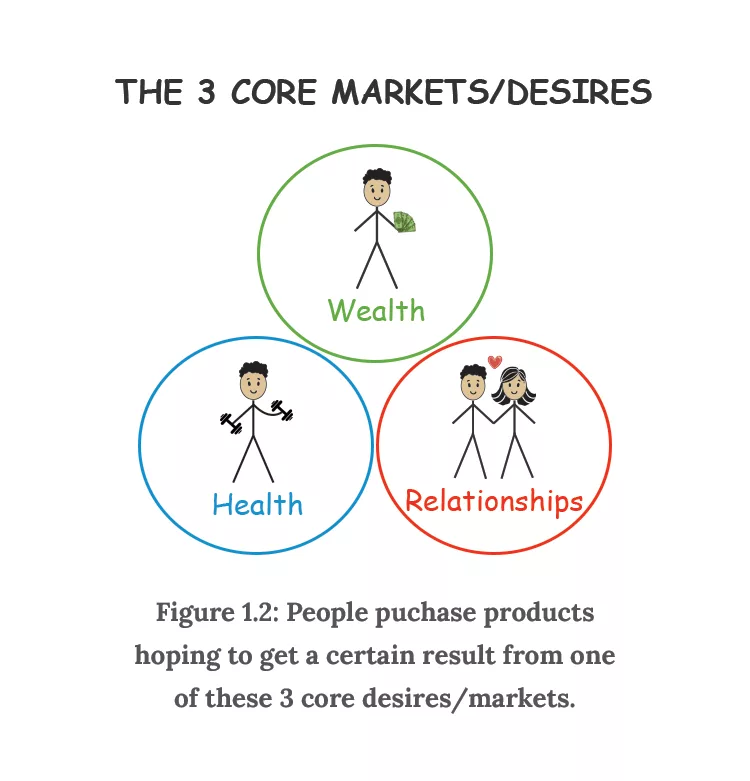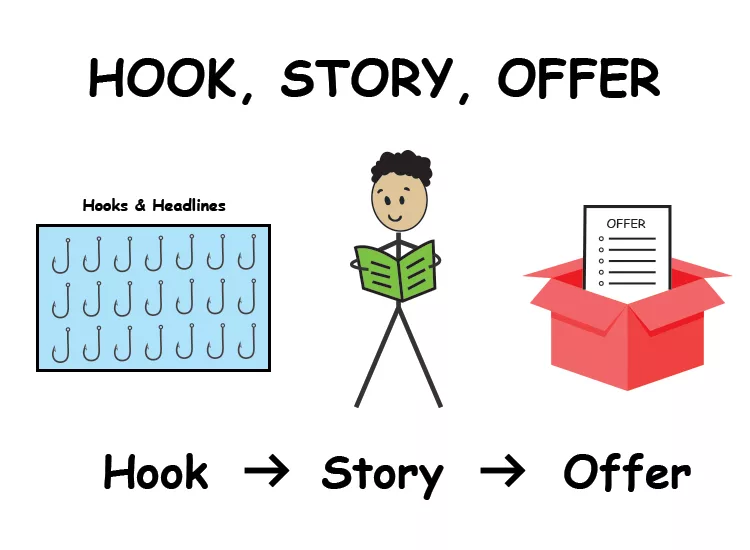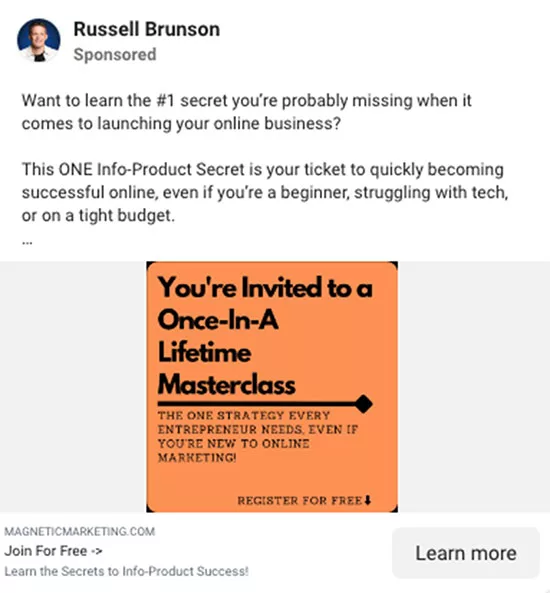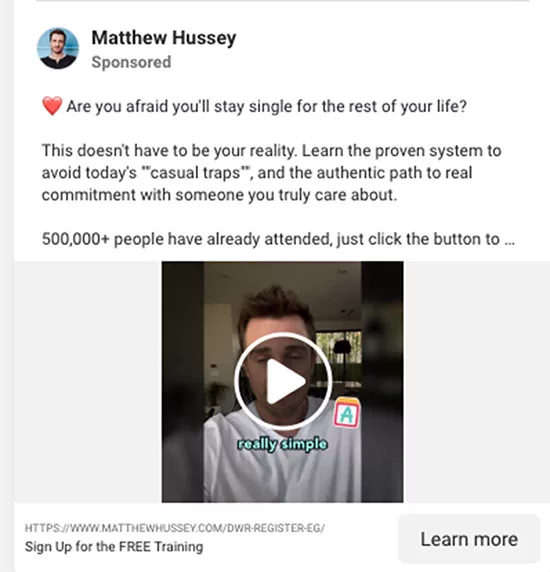Our view at Stack - ClickFunnels was founded by an online marketing legend Russell Brunson and it offers several benefits for online businesses and marketers:
- Time and Cost Savings: Efficiently create sales funnels without extensive development efforts.
- Maximized Conversions: Test offers, copy, and images to enhance conversions.
- Specific Landing Pages: Generate highly targeted landing pages.
- Predictable Pipeline: Create consistent, predictable sales paths.
- Increased Sales: On average, it boosts sales of lesser products by 15%
The post 5 Tips – Starting A Business From Scratch For Beginners appeared first on ClickFunnels.
Have you ever had an amazing business idea?
So many people come up with great ideas, share them with friends or family, and then talk about what life could be like.
For most people, talking is where the journey ends.
But you’re different.
If you’re reading this, you’re the 1% who are serious about making your business idea more than just a conversation. You want to take action. You want to change something in your life.
In this post, I’ve listed out the 5 most powerful tips to launch a business and start getting customers or sales.
I’m not going to sugarcoat it – building a business from scratch requires hard work. But if you’re serious about your business idea, this blog post is your fast track for actually making it happen.
So, let’s dive into our top 5 tips for starting a business from scratch as a beginner!
1. Identify Your Dream Customers
The 5 tips in this blog post come straight from Russell Brunson, the co-founder of ClickFunnels.
If you don’t already know, ClickFunnels has over 100,000 active customers and many of them started from scratch to build multi-million dollar businesses.
So there are fewer people more qualified on this subject than Russell.
The #1 Mistake Entrepreneurs Make
In Russell’s book Traffic Secrets, he talks about the biggest mistake that entrepreneurs make.
Here it is.
Too many entrepreneurs get so excited about their business idea or vision that they forget the people who actually make a business successful: the customers.
Hear me out.
I’m not saying you should get rid of your vision. In fact, I’m about to teach you how to harness that vision and turn it into the life-changing business you’re dreaming of.
And that starts with identifying your dream customers first.
Here’s Russell:
“[Entrepreneurs] believe that if they build a great product, or create an amazing company, the customers will automatically follow. I see entrepreneurs who will invest every last penny they have to create the products and services they think will change the world without ever considering who their dream customers are or how they’re going to reach them.”
And it’s not just Russell who believes this.
Check out these quotes from some of the most successful business people in the world.
- Jeff Bezos, Founder of Amazon:
“We’re not competitor-obsessed, we’re customer-obsessed. We start with what the customer needs and we work backwards.” - Sam Walton, Founder of Walmart:
“There is only one boss. The customer. And he can fire everybody in the company from the chairman on down, simply by spending his money somewhere else.” - Steve Jobs, Co-Founder of Apple:
“You’ve got to start with the customer experience and work back toward the technology – not the other way around.”
Instead of diving headfirst into building a product or service, you need to ask yourself one critical question:
- Who is your dream customer?
A lot of the time, your dream customer is someone who’s just like you.
They’re people you understand deeply or they’re members of a community you’re also a part of.
If you’ve come up with a business idea yourself, it’s likely a solution to a problem you’ve faced in your own life.
And that’s the best kind of business to start – one that solves a problem you know intimately.
Creating Your Customer Avatar
So, how do you figure out who your dream customer is?
Start by filling out the ClickFunnels customer avatar template below.

This tool will help you clarify who your dream customers are, what they care about, and where you can find them.
The more specific you can be, the better your chances of reaching and connecting with the people who will become the lifeblood of your business.
If your business idea is more like a brick-and-mortar business, where your customers are only going to be those in a local area, the same applies.
Perhaps instead of looking at magazines or blogs & websites you can think about:
- NextDoor communities
- Local Facebook Groups
- Local newspapers
- Restaurants, bars, or coffee shops where they hang out
- Neighborhoods where they live
Building out a customer avatar may seem like a tedious place to start.
But I promise you this is the best foundation block to build your business on – and will help you nail Tip #2 way faster.
Click Here to Get Traffic Secrets for Free!
2. Find an Unmet Desire
All businesses, whether they sell a product or service, exist for one simple reason: to solve problems.
Usually, the problem manifests because someone has an unmet desire in their life.
That’s the driving force behind why people want to buy.
Yet, many businesses fail because they only look inward at their products or services, never truly understanding the people who will buy from them.
So, how do you figure out what your dream customers really want?
As Russell Brunson explains in Traffic Secrets, there are only three core desires that drive every purchase:
- Health
- Wealth
- Relationships
Here’s Russell:
“When people purchase any product from anyone, they’re hoping to get a certain result in one of these three areas of their lives.”

So, how does this apply to your dream customers?
First, you need to determine which of these three core desire buckets your dream customers are focused on. Is their primary desire to improve their health, increase their wealth, or enhance their relationships?
To illustrate how powerful these core desires are, let’s look at five famous slogans from businesses that sell billions of dollars by marketing to one of these desires:
- Gillette – “The Best a Man Can Get”: This iconic slogan isn’t just about shaving; it’s about relationships. It speaks to the desire for men to look and feel their best, which ties directly into their relationships with others.
- Apple – “Think Different”: This campaign appeals to the desire for wealth – not just in terms of money, but in creating and being part of something innovative and revolutionary, which can lead to greater success.
- Nike – “Just Do It”: Nike taps into the desire for health. It’s not just about selling shoes; it’s about inspiring people to take control of their physical well-being and push themselves to achieve more.
- L’Oréal – “Because You’re Worth It”: This slogan is about relationships, particularly the relationship one has with oneself. It encourages self-confidence and self-care, which resonates deeply with consumers looking to feel good about themselves.
- De Beers – “A Diamond is Forever”: This classic slogan appeals to the desire for relationships, symbolizing eternal love and commitment through the purchase of diamonds.
While your product or service may touch on multiple desires, your marketing message should focus on just one of these core desires.
This laser focus ensures that your message resonates deeply with your dream customers.
Joining Your Dream Customers in Their Own Conversations
Not sure which of the three desires your dream customers want?
Do some research.
Go back to your customer avatar document and search through forums, websites, social media groups, or other sources of information where your potential customers hang out.
Make a list of at least a dozen things they’re saying or thinking.
For example, in Traffic Secrets, Russell provides examples of phrases people use that reflect the pursuit of their desires.
He splits the phrases into two columns:
- Moving away from pain
- Moving toward pleasure

This is one of the most powerful uses of your time if you’re looking to start a business from scratch.
It might seem tedious, but trust me, it will pay off in the next section as we delve deeper into crafting a message that grabs your audience’s attention.
Click Here to Get Traffic Secrets for Free!
3. Throw Out Hooks
One of the most powerful concepts in Traffic Secrets is Russell Brunson’s Hook, Story & Offer framework.
Whenever Russell hears someone say their business isn’t making any sales, he almost always traces the problem back to one of these three areas.
Most of the time, it’s an issue with the hook.
Often, the root cause is that the business owner hasn’t done their homework in the first two sections—identifying their dream customer and finding an unmet desire.
But now that you’ve done that, you’re ready to create compelling hooks that grab attention and drive engagement.

Understanding the Hook
So, what exactly is a hook?
A hook is the first sentence that pulls your audience in.
The purpose of the hook is to get someone to stop what they’re doing and pay attention to your message.
Without a strong hook, even the best stories and offers will go unnoticed.
Let’s look at some examples of hooks in different formats:
- Emails: A subject line that piques curiosity, such as “The one thing that everyone gets wrong when starting a business…”
- Instagram posts: A bold opening line like, “Ever wonder why your morning routine is ruining your day?”
- Facebook posts: An eye-catching statement, “I doubled my income in 30 days—here’s how you can too.”
- YouTube thumbnails: A thumbnail with a shocking image and text overlay like, “This mistake cost me $10,000!”
- SMS: A quick, attention-grabbing text, “Limited time offer—Don’t miss out on 50% off!”
In addition to these online hooks, businesses have been using offline hooks for decades.
Think about the end-cap displays in supermarkets that showcase “limited time” products, or the giant banners you see in stores promoting a flash sale.
These hooks are designed to catch your attention as you walk by, making you stop and take notice.
Basically, anything that grabs your attention is a hook.
Creating Your Own Hooks
Now it’s time to create hooks of your own.
The key is to base your hooks on the exact sentences your dream customers are saying, which you identified in the previous section.
Whether they’re moving away from pain or towards pleasure, your hooks should speak directly to these emotions.
Here are five examples of ads from successful businesses where the hook clearly taps into one of the three core desires (health, wealth, relationships) and aligns with the customer’s movement away from pain or towards pleasure:

1. Sabri Suby – “This FLOODED my business with clients”…**: This Facebook Ads hook from leading Australian marketer Sabri Suby speaks to any business owner trying to move away from the pain of having not enough clients and sales. This clearly taps into the ‘wealth’ desire bucket.

2. Russell Brunson – “Want to learn the #1 secret you’re probably missing when it comes to launching your online business”: This hook from Russell Brunson, the ClickFunnels co-founder, talks to anyone looking to start an online business. Another hook tapping into the ‘wealth’ desire bucket.

3. MindValley – “So many of us are drenched in stress and we don’t even realize that there could be any other way to live a life.”: Mindvalley is a nine-figure business in the online health and wellness industry. This hook speaks directly to anyone experiencing stress or anxiety in their lives and taps into the ‘health’ desire bucket.

4. Kayla Itsines – “Short workouts you can do AT HOME, so that you can get on with your busy day!”: Kayla Itsines is the co-creator of the Sweat app, which offers a variety of online fitness programs and is one of the highest-grossing fitness apps globally. This hook speaks to dream customers who struggle to find the time for exercise but still want to improve their health.

5. Matthew Hussey – “Afraid you’ll stay single for the rest of your life?”: Matthew Hussey is one of the biggest in the relationship industry online. This hook taps into the desire for better relationships, but talking about the pain someone feels that they’ll be single for good.
Practicing Your Hooks
The hook is everything when it comes to grabbing attention.
A strong hook also filters out anyone who isn’t your dream customer and speaks directly to the people you’re looking to help.
So how to get started?
To practice creating hooks, go into forums or groups where your dream customers are active and start engaging with them.
You don’t even need to sell anything at this stage.
Just start a conversation.
See if you can get likes or comments on a post.
Once you can grab your dream customers’ attention, you can lead them through the story and ultimately to the offer.
But it all starts with a great hook.
4. Tell a Story
After you’ve caught someone’s attention with a compelling hook, you can’t just jump straight into making your offer.
That’s like proposing marriage on the first date.
It’s too much, too soon.
Instead, you need to warm your dream customer up with a story to get them into the right state of mind to consider buying.
Russell Brunson explains exactly how to do this in his book Expert Secrets with the Epiphany Bridge script.

The core idea is simple but powerful: people don’t buy on logic—they buy on emotion.
To get someone to understand your big idea or vision, you can’t just show them the product and expect them to feel the same way you do.
You need to create an emotional connection.
Let’s say you’ve thrown out a hook that appeals to a specific dream customer who is moving towards something they really want.
You need to tell a convincing story about how you, or someone they can relate to, achieved that same outcome.
This story acts as a ‘bridge’.
Here are five examples of businesses that have effectively used an Epiphany Bridge story to sell a product or service:
- Subway – Jared Fogle’s Weight Loss Story: Subway famously used the story of Jared Fogle, who lost a significant amount of weight by eating Subway sandwiches. His personal journey resonated with many and made the idea of eating healthier with Subway sandwiches relatable and achievable.
- Proactiv – Celebrity Success Stories: Proactiv has used the stories of celebrities like Jessica Simpson and Kendall Jenner, who struggled with acne and found success with Proactiv. These stories make the product relatable and demonstrate its effectiveness through real-life experiences.
- Peloton – Customer Transformation Stories: Peloton frequently shares stories of its users who have undergone significant physical and mental transformations using their equipment and classes. These stories create an emotional connection with potential customers who are looking for similar results.
- Apple – “Think Different” Campaign: Apple’s “Think Different” campaign didn’t just sell computers; it sold the idea of being innovative and revolutionary, telling the stories of iconic figures like Albert Einstein and Mahatma Gandhi. This connected with customers who saw themselves as visionaries or disruptors.
- TOMS – One for One Movement: TOMS used the story of its founder, Blake Mycoskie, and his mission to provide shoes to children in need. Every time a customer bought a pair of shoes, TOMS would donate another pair to someone in need. This story resonated with consumers who wanted to make a difference, driving both sales and social impact.
To practice this, start adding a story to the hooks you’ve been making.
Talk about how you, or a believable character, achieved the result your audience is looking for in a way that gets them emotionally invested.
If you start getting responses like “How can I do that?” or “Can you show me more?” then you know you’ve successfully connected with your audience.
Now you’re ready for the final stage of starting a business from scratch!
5. Make an Offer
The last piece of the puzzle is making an offer.
This is the third step in the Hook, Story, Offer framework.
- The hook grabs attention
- The story keeps the person engaged and gets them emotionally invested
- The offer is what gets them to take action
In his book Traffic Secrets, Russell Brunson says that if people are engaging with your hooks and stories but aren’t buying or doing what you want, then you need to increase the value of your offer.
As the legendary marketer Dan Kennedy used to say, “Make an offer so good that people feel stupid saying no.”
There are several ways to increase the value of your offer:
- Pricing Strategies: You can create tiered pricing options that provide more value at different levels. For example, offering a basic package, a premium package with extra features, and an exclusive package with one-on-one coaching.
- Guarantees: Offering a money-back guarantee or a satisfaction guarantee can reduce the perceived risk for your customers, making them more likely to take action. For example, a 30-day money-back guarantee if they’re not satisfied with the results.
- Bonuses: Adding additional bonuses can make your offer more attractive. These could include extra resources, access to a private community, or a free consultation. For instance, if you’re selling an online course, you might include a bonus eBook or a series of follow-up webinars.
- Scarcity and Urgency: Limited-time offers or exclusive deals create a sense of urgency, encouraging people to act quickly. For example, offering a special discount for the first 100 customers or a bonus that’s only available for the next 48 hours.
- Testimonials and Case Studies: Showcasing success stories and testimonials from satisfied customers can significantly increase the perceived value of your offer by providing social proof.
To practice making offers, start small.
Your offer doesn’t have to involve money at first.
You could try to get someone to sign up for a free call, fill out a survey, download a lead magnet, or join your newsletter. This will help you understand what works and refine your approach.
But don’t be discouraged—many successful entrepreneurs started by offering their services for free to build experience and rapport.
Here are a few examples:
- Alex Hormozi: Alex Hormozi, now a successful entrepreneur and author, started by offering free fitness consulting services. He provided his expertise to gyms for free, which helped him build a track record and eventually scale his business, Gym Launch, into a multi-million-dollar company.
- Tony Robbins: Tony Robbins, one of the most famous life coaches in the world, initially started by offering free coaching sessions. He wanted to practice and refine his techniques, which eventually led to paid clients and the launch of his global personal development empire.
- Gary Vaynerchuk: Before becoming a well-known entrepreneur and social media guru, Gary Vaynerchuk offered free advice and consulting to build his personal brand. He spent years providing free content and advice on wine and social media, which helped him grow his following and eventually led to lucrative business opportunities.
If you can’t even get someone to take up an offer that costs nothing, you’ll have a hard time convincing people to buy your paid offers.
Oh, and by the way…
If you want a quick and easy way to do any of the things mentioned above, then check out ClickFunnels.
With ClickFunnels, you can quickly build a professional-looking website, create landing pages that capture leads, and set up automated email sequences to nurture your prospects—all without needing any technical skills.
It’s the perfect tool for entrepreneurs who want to start a business from scratch and grow it into something profitable.
Try ClickFunnels Free for 14 Days!
Final Thoughts on Starting a Business From Scratch for Beginners
A lot of content out there makes starting a business seem incredibly complex and daunting.
You’ll hear about all the regulations, the need for investments and capital, patents, and business protection.
While these things are important, they aren’t what truly builds a business.
Building a business is simple at its core.
It’s about throwing out a good hook, telling a compelling story, and making a strong offer.
That’s it.
These are the only three variables you really need to focus on to start a business from scratch.
Get these right, and you’ll be well on your way to building something successful.
So don’t get overwhelmed by all the noise—focus on mastering your hook, story, and offer, and the rest will follow!
Thanks for reading 5 Tips – Starting A Business From Scratch For Beginners which appeared first on ClickFunnels.
If Click Funnels is of interest and you'd like more information, please do make contact or take a look in more detail here.
Credit: Original article published here.
